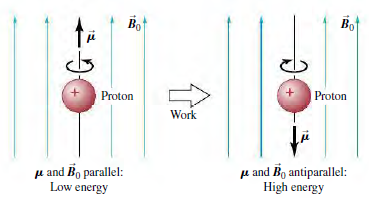The large magnetic fields used in MRI can produce forces on electric currents within the human body.
Question:
(a) 6 × 10-7 N;
(b) 1 × 10-6 N;
(c) 3 × 10-4 N;
(d) 0.3 N.
Magnetic resonance imaging (MRI) is a powerful imaging method that, unlike x-ray imaging, allows sharp images of soft tissue to be made without exposing the patient to potentially damaging radiation. A rudimentary understanding of this method can be achieved by the relatively simple application of the classical (that is, non-quantum) physics of magnetism. The starting point for MRI is nuclear magnetic resonance (NMR), a technique that depends on the fact that protons in the atomic nucleus have a magnetic field BÌ…(vector). The origin of the proton€™s magnetic field is the spin of the proton. Being charged, the spinning proton constitutes an electric current analogous to a wire loop through which current flows. Like the wire loop, the proton has a magnetic moment µÌ…(vector); thus it will experience a torque when it is subjected to an external magnetic field BÌ…0(vector). The magnitude of µÌ…(vector) is about 1.4 × 10-26 J/T. The proton can be thought of as being in one of two states, with µÌ…(vector) oriented parallel or antiparallel to the applied magnetic field, and work must be done to flip the proton from the low energy state to the high-energy state, as the accompanying figure (next page) shows.

An important consideration is that the net magnetic field of any nucleus, except for that of hydrogen (which has a proton only), consists of contributions from both protons and neutrons. If a nucleus has an even number of protons and neutrons, they will pair in such a way that half of the protons have spins in one orientation and half have spins in the other orientation. Thus the net magnetic moment of the nucleus is zero. Only nuclei with a net magnetic moment are candidates for MRI. Hydrogen is the atom that is most commonly imaged.
Step by Step Answer:

University Physics with Modern Physics
ISBN: 978-0133977981
14th edition
Authors: Hugh D. Young, Roger A. Freedman





